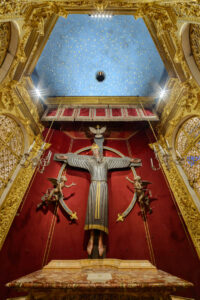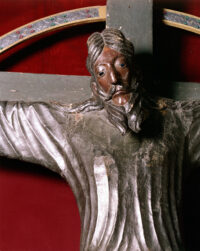 A revered crucifix in the Cathedral of Saint Martin in Lucca has been discovered to be hundreds of years older than previously believed, making it the oldest surviving wooden sculpture in Europe. The Volto Santo (Holy Face) di Lucca is a monumental sculpture more than eight feet long depicting Christ on the cross. It is itself a holy relic and as such has never been radiocarbon dated before because the testing requires taking samples and destroying a part of the cross.
A revered crucifix in the Cathedral of Saint Martin in Lucca has been discovered to be hundreds of years older than previously believed, making it the oldest surviving wooden sculpture in Europe. The Volto Santo (Holy Face) di Lucca is a monumental sculpture more than eight feet long depicting Christ on the cross. It is itself a holy relic and as such has never been radiocarbon dated before because the testing requires taking samples and destroying a part of the cross.
This year marks the 950th anniversary of the dedication of the cathedral. As part of program of events to celebrate its venerable history, the Cathedral of San Martino asked the Institute of Applied Physics and the National Institute of Nuclear Physics to analyze and date the sculpture. Technology now allows for radiocarbon dating extremely small samples, so for the first time, permission was granted to remove tiny bits for testing. Four samples were taken from different places on the crucifix — three of the wood and one fragment of canvas affixed between the wood and the paint in a technique known as incamottatura. They were carefully treated and cleaned to remove any organic residues or varnishes that might alter the data. The dates of all the samples converged around the early 9th century, but the possible range goes back as far as the late 8th century to the middle of the 9th.
That early potential date sets off a frisson of excitement, because it matches the legend behind the sculpture. According to the traditional tale relayed in a 12th century manuscript, the statue was carved by Nicodemus, the Pharisee who helped Joseph of Arimathea wrap the body of Jesus after the crucifixion, but as he was Jewish and therefore prohibited from depicting a human visage, angels carved the face of Christ, hence the “Volto Santo” even though it’s a full-bodied sculpture.
 For 700 years it remained hidden in the city of Ramla, modern-day central Israel, where it was rediscovered by a northern Italian bishop named Gualfredo during his pilgrimage to the Holy Land. An angel came to him in a dream and told him where to find it. He had it loaded onto a ship at Jaffa and put it out to sea without a crew or sails, praying that it would reach Christian lands. It reached the town on Luni the northern coast of the Tyrrhenian Sea. John I, Bishop of Lucca, was visited by an angel in a dream and told to fetch the Volto Santo from Luni. The feat accomplished, he brought the statue to Lucca in 782, the second year of the reign of Pepin, son of Charlemagne, as King of Italy.
For 700 years it remained hidden in the city of Ramla, modern-day central Israel, where it was rediscovered by a northern Italian bishop named Gualfredo during his pilgrimage to the Holy Land. An angel came to him in a dream and told him where to find it. He had it loaded onto a ship at Jaffa and put it out to sea without a crew or sails, praying that it would reach Christian lands. It reached the town on Luni the northern coast of the Tyrrhenian Sea. John I, Bishop of Lucca, was visited by an angel in a dream and told to fetch the Volto Santo from Luni. The feat accomplished, he brought the statue to Lucca in 782, the second year of the reign of Pepin, son of Charlemagne, as King of Italy.
Its first appearance on the historical, rather than hagiographic, record is when Bishop Anselmo da Biaggio presented it to the cathedral of Lucca at its consecration in 1070. Art historians have long thought based on the carving style that the sculpture now in the cathedral was made after that date, that it was a mid-12th century copy of a lost original that was the kernel of truth in the legend. The C-14 results prove that it is not a later medieval copy, but the original Volto Santo and it could even date to the time when legend says it arrived in Lucca.